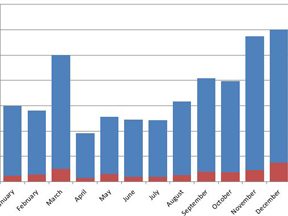The holidays are over. Your business is returning to normal. As you start a new year, review your business’s performance in 2013. Once you’ve completed your review, create a plan for 2014.
Ask for input from your staff, advisors, and suppliers. But don’t rely on them for all the answers. Do your own research.
Ecommerce executives should review the key performance indicators of their businesses. You will likely find some things you did very well and some things that can be improved.
Where do you start with this review? I will provide a framework in this article.
Key Areas to Review
- Store traffic. Look at visits, unique visitors, page views, time on site, bounces, and other statistics and compare them to the previous year (2012). Break your analysis down by quarter to identify current as well as seasonal trends.
- Referral sources. Organic search engine referrals have declined for many online stores in the last two years. It’s more difficult to track which keywords are sending you traffic,. Get good baseline numbers from 2013 to set new KPIs for 2014.
- Mobile traffic and sales. You must be mobile friendly to be competitive. Tablet friendly is not good enough. You need a smartphone friendly store. Review your performance and look for ways to improve as the traffic from those devices is only going to grow more dramatically this year.
- Revenue. Break it down by product line, new and repeat customers, referral sources. Look for the growth areas and the laggards.
- Gross and net margins. Did you meet the goals you set in the beginning of the year. Are you trending up or down? Do you have better margins within a specific product group or customer segment?
- Inventory. It’s too easy to assume that your physical inventory is accurate if you have an automated inventory system. Even if you conduct spot checks to validate your numbers throughout the year, it’s good to take an actual, comprehensive inventory at least once a year. This is an area almost every ecommerce business can improve on. Most physical inventories result in shortages. It’s better to write them off now rather than later.
- Shipping costs. Take time to understand if you are losing money on shipping; you probably are if you offer free shipping. Evaluate the effectiveness of your current policies. Consider new carriers or offers.
- Personnel costs. It’s early in the year. Are your labor costs in line with your budgets and profitability? Consider that employees will expect raises. Make sure you factor that into your yearly budget.
- Suppliers. Determine the suppliers you are spending the most money with. Are there alternative sources that may be less expensive? Can you buy in larger quantities to gain higher discounts?
- Customer service results. What direct feedback have you received from customers? What is your return rate? How many customer service calls were opened? How long did it take for you to close them? What are your ratings and reviews in third-party marketplaces?
- Marketing effectiveness. Review your paid advertising performance, your email effectiveness, and your social media analytics. Which contribute to traffic? Which contribute to revenue? Where do you see growth and attrition?
There are many other KPIs that may be unique to your business.
Now What?
- Create top 10 lists. List the top 10 things you did well in 2013. List the top 10 things that need improvement. Review those with your management team. Give credit where it’s due, then tackle the things that need improvement. Set new objectives for all items and develop a plan to meet those objectives. Make sure you have systems in place to measure your success. Make sure you are doing this for both lists. Stretch your goals on the things you did well also.
- Create new business goals. There may be some overlap here, but take the time to set new KPIs for 2014 for each of your functional areas. Communicate them to your teams and ask them for input and support in achieving the new goals. As with your top 10 list, be sure to put processes in place to track your improvement.
- Create a budget. I know it’s painful, but create an annual budget and review it monthly or quarterly. A budget is really just a KPI for you to measure your overall financial performance. Managing from a budget will allow you to identify trends quickly and act on problem areas. Without one, it’s easy to lose site of hidden costs and slow declines.
- Connect with your customers. Conduct a survey. Ask your customers what you can do better to serve them. Ask them what products interest them and why they buy them from you or other stores. Find out what you can do to gain more of their business.
- Connect with your employees. Survey your employees or talk to them one on one. Find out what motivates them and demotivates them. Ask them for ideas to help the company’s performance. Ask them what you can do for them to make them more productive and loyal.
- Connect with your key suppliers. Most retail businesses have a few key suppliers where they buy most of their products. Talk to your suppliers’ sales representatives about the trends they see in their business. Ask them what products they recommend you add to your store. Ask them for bestseller lists. Probe ways to lower your cost of goods sold.





